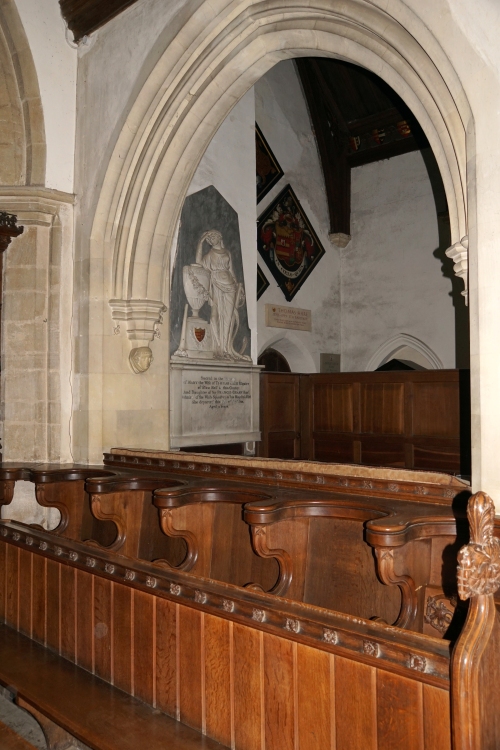Some time ago I wrote about the organisation of space inside churches in the Georgian period. Social stratification became very clear in the way seating was organised and splendid box pews were built and were bought and sold or rented out. “To be SOLD, A PEW, in the West Gallery of the Parish Church, at Leeds, well situated for both Hearing and Seeing, and containing Sittings for Five People,” read the advertisement in the Leeds Intelligencer in October 1789.
I was reminded that as well as private pews in the body of the church it was possible to construct even more exclusive accommodation if you had the status and the position in the parish.
I had travelled to the Norfolk church of Holy Trinity, Stow Bardolf, to the south of King’s Lynn, in pursuit of one particular (and startling) memorial – of which more later – and was struck by the family pew of the lords of the manor which is situated like nothing so much as a theatre box next to the choir.
Stow Hall, which was sited within sight of the church, was the home of the Hare family who acquired the estate in 1553. In 1641 they were created baronets and this is probably what prompted them to construct a family chapel on the north side of the chancel with its own exterior door. It has a number of imposing monuments including Sir Thomas Hare who died in 1693 and is shown reclining in full Roman armour but, ludicrously, wearing his wig.
At some point someone had the bright idea of knocking through the wall behind the north choir stall to create the open front of a large family pew, enclosed in wood panelling and with a door into the family chapel. The Hares could therefore walk or drive to the churchyard gate nearest the Hall and enter through their own private door without having to mingle with the lesser folk of the parish.

Above is the view from the altar steps. Once seated in their pew, high enough to look down on the heads of the choristers below, the family were almost completely private. Behind the pew you can glimpse some funeral hatchments and below them the outside door.
 The 19th century family would have worshipped under the gaze of the figure of Hope on the memorial to Mary Hare who died in November 1801. Hope is leaning on an anchor (her symbol) which also serves as a reminder that Mrs Hare’s father, Sir Francis Geary, Bart., was an Admiral of the White. The upside-down torch leaning against the urn is a symbol of a life snuffed out. Usually the length of the torch is an indication of the length of the life of the deceased.
The 19th century family would have worshipped under the gaze of the figure of Hope on the memorial to Mary Hare who died in November 1801. Hope is leaning on an anchor (her symbol) which also serves as a reminder that Mrs Hare’s father, Sir Francis Geary, Bart., was an Admiral of the White. The upside-down torch leaning against the urn is a symbol of a life snuffed out. Usually the length of the torch is an indication of the length of the life of the deceased.
In the photograph of the pew you can just see the pointed top of something wooden and that is what I had come to Stow Bardolf to see. At first sight it appears to be a cupboard, almost like a small, rather shallow mahogany wardrobe.
Over the door is an inscription which reads:
Here Lyeth the Body of Sarah Hare Youngest Daughter of Sr Thomas Hare Bart. And Dame Elizabth. His Wife And Sister To The Present Sir Thos Hare Who Departed This Life The IX Day Of Apr MDCCXLIV [1743] And Ordered This Effigies [sic] To Be Placed Here.
That is all the warning the unwary visitor has before they open the door and come face to face with Sarah Hare.

She is life-sized, the only wax funerary effigy in the UK outside Westminster Abbey and she died aged eighteen from blood poisoning after pricking her finger with a needle while doing embroidery. Poor Sarah lived long enough to realise that she must make her will and in it she left very specific instructions.
She was to be buried by six poor men of the parish who were to be paid five shillings each. “I desire to have my face and hands made in wax with a piece of crimson satin thrown like a garment in a picture, hair upon my head and put in a case of Mahogany with a glass before.” Her grieving family carried out her instructions to the letter. After the first shock on opening the cabinet it is very moving to come face to face with a woman of the 18th century shown just as she was, without any attempt to make her look ‘perfect’. Sarah has a double chin, a rather severe mouth and a mole on her right cheek and she looks beyond the viewer as though failing to notice that we are there. Her right hand looks swollen – perhaps a result of the infection that killed her.
An unsettling, but fascinating, encounter with a real woman.



 There’s a very similar recipe in The Complete Confectioner (1815) by Fredrick Nutt with the note: N.B. These are very good for the stomach in cold weather.
There’s a very similar recipe in The Complete Confectioner (1815) by Fredrick Nutt with the note: N.B. These are very good for the stomach in cold weather.
